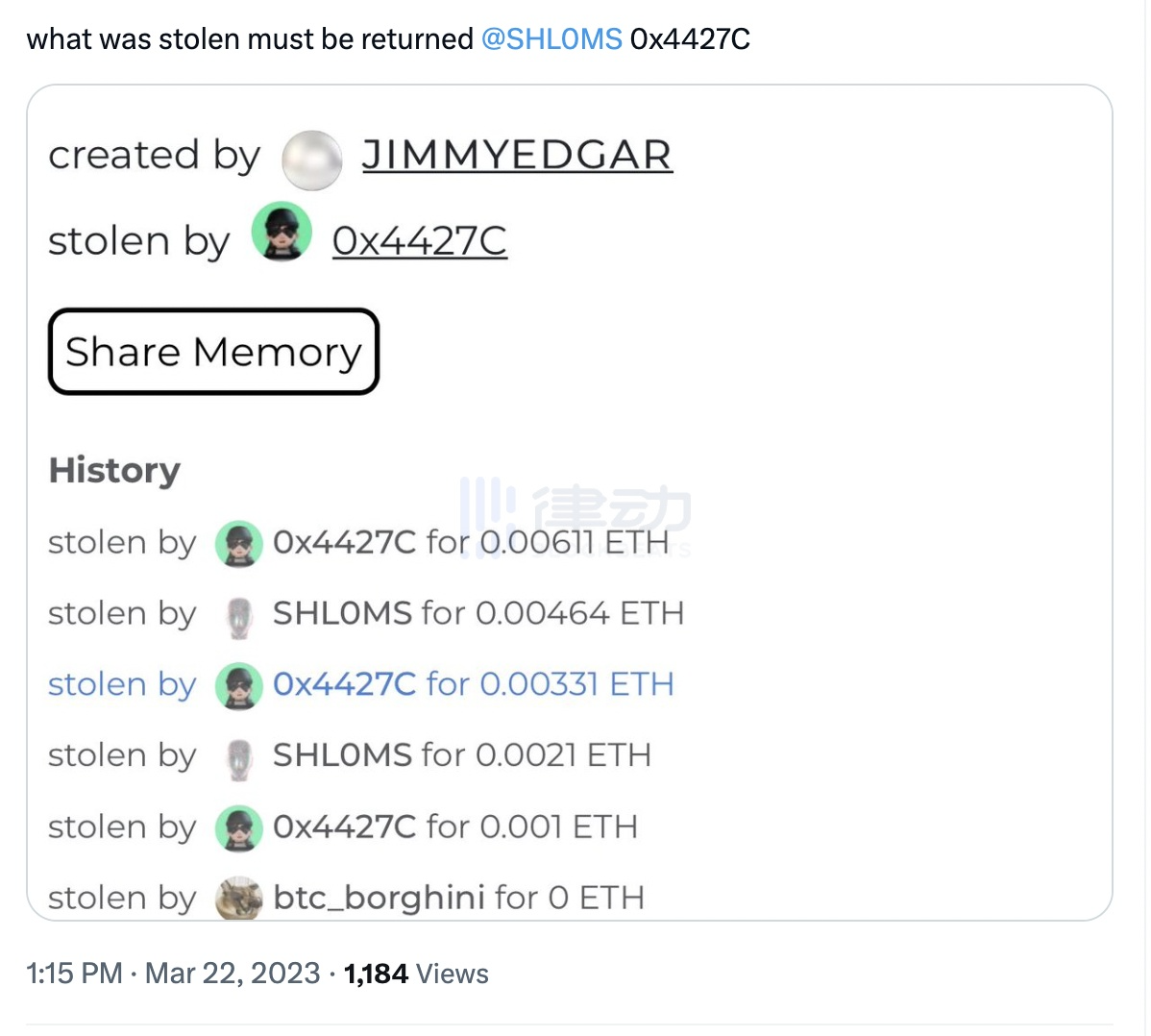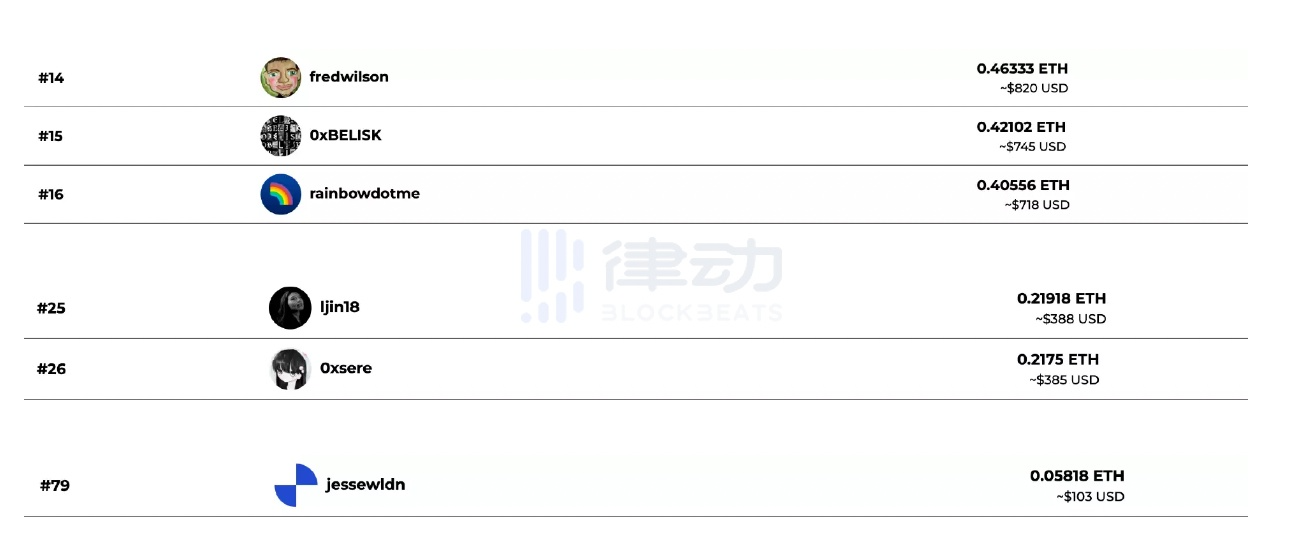Detailed Explanation of friend.tech's "Predecessor" stealcam: A Perfect Combination of Voyeurism and Owner Economy
Written by: LeftOfCenter
While everyone is celebrating the Arbitrum airdrop, a picture-sharing application in the Arbitrum ecosystem called Stealcam is quietly gaining momentum. In just two weeks, without relying on airdrop expectations or issuing tokens, it has accumulated a trading volume of over 313 ETH (approximately $500,000) solely through organic growth. Jesse Pollak, the development lead of Base, the core development team of OP Stack, described it as "his favorite unique on-chain new product."

This recently popular Web3 product, named Stealcam, is considered somewhat popular because the hype and attention in the crypto industry often correlate with TVL. From this metric, it indeed appears to be just a somewhat popular application, even somewhat insignificant.
However, during its beta phase, without airdrop expectations or token issuance, this image application still achieved a certain level of organic growth. The total trading volume generated in just two weeks since the beta launch reached $500,000. By adding a new distribution model (skillfully combining human voyeurism, celebrity effect, and owner economic model) on top of the existing image application, it attracted a large number of artists, KOLs, and VC partners, earning a good reputation.
What is Stealcam?
In simple terms, Stealcam is an image social sharing application where users can upload images or video files to the platform, which is similar to ordinary internet photo applications.
The difference is that the images published on this platform are not freely accessible; they require a "steal" (paying a certain fee, currently only supporting ETH payments) to gain the right to "reveal" (open the image) and then view the specific content of the image.
The "reveal right" is not held indefinitely; you can only view the content of the image if you are the most recent person to reveal it. Each image can be stolen an unlimited number of times, with each subsequent steal increasing the price by 10% plus an additional 0.001 ETH. If an image is very popular and many people participate in stealing, it is possible that after you steal it, when you want to reveal it, it has already been stolen by someone else (steal and reveal are two separate operations requiring two signatures). To view the content, you would need to steal it back again.
The revenue generated from each steal will fully refund the previous stealer's purchase cost, and the price difference generated from two steals will be distributed among the creator, the previous stealer, and the protocol, with the creator and the previous stealer receiving 45% and 10% respectively.

The revenue generated from each steal is refunded to the previous stealer, meaning the person being stolen from receives a full refund and can also earn a share of the price difference.
In summary, Stealcam adds a layer of pixelated censorship on top of traditional image social applications, allowing others to pay to browse content. By introducing a bidding incentive model, it includes all participants (creators and previous buyers) in the profit-sharing model, thus facilitating price discovery for the works.
Data and Team
Although it has only been two weeks since its launch and is still in the beta testing phase, the user interface appears somewhat rough. However, as a Web3 application, Stealcam's performance in terms of reputation and organic user growth is commendable.
From the data perspective, the number of images generated on the platform has surpassed 11,000, as can be seen from the latest published image IDs on the official website's discovery page, where the images are displayed in chronological order.
According to the Stealcam dune panel published by nazih.eth, the total number of steals for images published on Stealcam has reached 20,000, with a daily minting count peaking at 1,499 and a daily steal count peaking at 4,175, accumulating a trading volume of over 313 ETH (approximately $500,000) and user earnings totaling 40 ETH (approximately $68,000).
According to the TOP 10 income leaderboard on the official website, the top rank is held by NFT artist Shl0 ms, with earnings of 4.2 ETH (approximately $7,600), followed by the second and third ranks earning 3.6 ETH (approximately $6,551) and 1.87 ETH (approximately $3,331) respectively.

Scrolling down the Stealcam income leaderboard, we find that this application, still in beta testing, has attracted participation from crypto OGs, artists, and even Web3 applications. Among them, the 14th rank is held by Fred Wilson, co-founder of USV (Union Square Ventures), who earned 0.53 ETH by publishing 10 works on Stealcam. The 17th rank is held by the wallet application Rainbow, which earned 0.4 ETH by publishing images on Stealcam, while Li Jin, co-founder of the crypto fund Variant Fund, ranks 25th, and another Variant co-founder, Jess, ranks 79th.

The founding team consists of anonymous OG Racer (Twitter handle @0xRacerAlt) and shrimp (@shrimppepe).
Use Cases and Gameplay
As an image application, publishing and sharing images is certainly the most basic gameplay. Users can publish images/videos on Stealcam and then share them for others to pay to steal and view. Additionally, you can also pay to steal and view images from friends, colleagues, family, and others.
As a crypto application, there are also gameplay elements that differ from ordinary image-sharing applications. For Stealcam, this involves minting and stealing, incorporating all ownership economic mechanisms underpinned by the underlying crypto protocol, allowing all auction participants for an image to earn a portion of the revenue generated by that image.
Publishing Works: Especially Suitable for Artists
First, let's talk about minting.
Minting involves uploading works (including images/videos) to Stealcam, publishing them after pixelation, and waiting for others to pay to steal (reveal) and earn revenue.
Under Stealcam's default distribution mechanism, except for the first stealer who can reveal for free, each subsequent steal will generate revenue. The starting price is 0.001 ETH, which will increase at a fixed rate with each steal. The revenue generated from each steal, in addition to refunding the bid of the current stealer, will have the price difference from two steals distributed among the creator, the current stealer (equivalent to the seller), and the protocol, with the creator and the stealer receiving an equal share of 45% of the price difference.
This approach, which includes the stealer in the revenue distribution mechanism from the outset, is particularly suitable for artists publishing their works. It also effectively links ownership economics with community contributions, allowing for revenue distribution underpinned by the underlying crypto protocol.
In the current crypto bear market (with the NFT market being even more bearish), most NFT works experience almost no trading volume after minting. The so-called floor price is merely a psychological expectation set by holders, and it can be said that the lack of trading volume and liquidity is a predicament faced by most NFTs today.
In this context, if stealer participation is included in the revenue-sharing system from the beginning, meaning that as long as the work can be sold, 45% of the generated price difference will be immediately paid to the stealer, this will create positive feedback for NFT liquidity and promote price discovery for NFT works.
Since we acknowledge that liquidity is crucial and that price discovery is so challenging in today's NFT market, those who contribute to the final price discovery of a work are significant contributors and should rightfully share in the revenue generated by that work. This is also the essence of ownership economics: participants in a community should receive a portion of the value generated by that community, proportional to their contributions.
In Stealcam, this fairness is reflected in:
Creators will receive permanent royalties from their works, meaning that 45% of the price difference from each steal and the previous steal will be automatically allocated to the creator. This means that as long as the image continues to sell in the market, its creator/publisher will always receive a share of the sales revenue, equivalent to permanent copyright royalties.
Moreover, stealers not only receive a full refund of their steal costs but also earn 45% of the premium generated from a single steal (i.e., the price difference between two steals).
Steal contributors can earn 45% of the revenue generated from a single steal, considering their contribution to the price discovery of the current transaction for that work. This is a very reasonable distribution, while the publisher earns an additional 45% from the price difference in each auction, creating a distribution that runs through every auction, effectively equating to permanent copyright.
While we continue to debate whether "creator royalties should be optional or mandatory" and whether "the NFT market should be buyer or seller-driven," this kind of "just right" compromise distribution mechanism may be a solution worth considering.
Of course, if we also consider fan economics, for example, if the publisher is part of the community or person participating in the auction (whether a writer, musician, director, or artist), then participating in the auction in this way is no longer purely a profit-making action but rather a community-driven endeavor that also allows for some earnings.
Stealcam also provides a very user-friendly "fan management" interface. On the "top fans" tab of the personal account page, Stealcam ranks each user's fans based on the number of steals, making it easy to view interaction data with their fans.

It is worth noting that although Stealcam's user interface is still somewhat rough, it shows great sincerity in the "income withdrawal" feature, as the revenue generated from each auction is immediately transferred to the user's wallet without delay or the need for manual withdrawal, allowing users to see their current earnings displayed in their wallets.
Purchasing and Investment Strategies: How to Earn Price Differences Through Stealing
In addition to publishing and sharing works while enjoying a permanent 45% royalty from price differences, users can also earn income by stealing others' works.
The most secure way to participate is to steal the first reveal right of an image, with zero cost plus very low gas fees. As long as another stealer appears, you can earn 0.001 ETH. However, that’s all; if the work is later sold for 100 ETH, it has no bearing on you. This is the safest and least risky way to participate.
Another method is to choose to join the bidding in the mid to late stages of a popular work. According to platform rules, each steal price will increase by 10% based on the previous steal, so the later you enter, the higher your share of the earnings, but the corresponding risk factor also increases. Of course, this method carries certain costs and higher risks; if the work cannot be stolen by the next person after you take it, you become the last holder of that work. Therefore, market expectations should be considered when choosing, such as works released by celebrities, well-known artists, or those from highly popular communities, which is known as the celebrity effect.
What Else Can Be Done? Expectation Management, Creating Hype, and Releasing Teasers
Beyond conventional gameplay, what potential use cases and gameplay does Stealcam offer?
Publishers can use Stealcam to release a series of "sneak peek" teasers, allowing fans to reveal and peek. Fans can obtain reveal rights through stealing, stimulating curiosity and word-of-mouth for future works to be released. These works should not be limited to images; they should also support music previews, movie trailers, etc. Moreover, creators should not be limited to artists but should include a broader range of creators, including musicians, directors, writers, photographers, esports streamers, adult film stars, AI virtual characters, communities, and corporate brands.
In fact, some corporate brands have already begun operating on Stealcam. For example, the NFT social platform Showtime has minted NFTs on Stealcam to release teasers for future product features. Showtime is not the only product using Stealcam to preview new features; the Rainbow wallet has also attracted user attention by releasing teasers for future product functionalities.

The Rainbow wallet releases a teaser for "future product features" on Stealcam.
For the crypto industry, which is closely related to financial investment, teasers represent alpha, previews of new features from project teams, or announcements of roadmaps, all of which have absolute appeal to crypto users and holders. However, this type of teaser plays on information asymmetry, so the later the reveal, the less attractive the information becomes, necessitating a customized auction pricing model.
It is important to note that there are many impersonators on Stealcam posing as celebrities. It is advisable to verify carefully when stealing, as Stealcam currently only supports Twitter authorization for authentication and allows for anonymity. Therefore, the only way to verify is to check the linked Twitter account on the publisher's personal page to see if it belongs to them.












